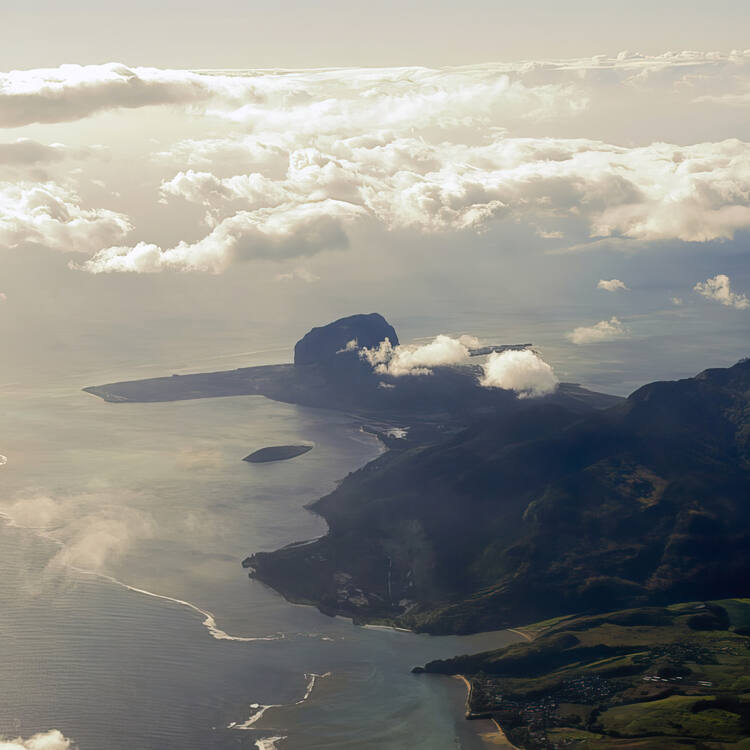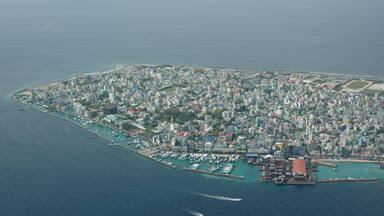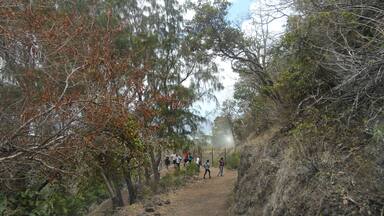Le Morne Cultural Landscape
Le Morne Cultural Landscape
Le Morne Cultural Landscape, a rugged mountain that juts into the Indian Ocean in the southwest of Mauritius was used as a shelter by runaway slaves, maroons, through the 18th and early years of the 19th centuries. Protected by the mountain’s isolated, wooded and almost inaccessible cliffs, the escaped slaves formed small settlements in the caves and on the summit of Le Morne. The oral traditions associated with the maroons, have made Le Morne a symbol of the slaves’ fight for freedom, their suffering, and their sacrifice, all of which have relevance to the countries from which the slaves came - the African mainland, Madagascar, India, and South-east Asia. Indeed, Mauritius, an important stopover in the eastern slave trade, also came to be known as the “Maroon republic” because of the large number of escaped slaves who lived on Le Morne Mountain.
Description is available under license CC-BY-SA IGO 3.0
Paysage culturel du Morne
Le Paysage culturel du Morne est une montagne accidentée qui s’avance dans l’océan Indien au sud-ouest de l’île Maurice et qui a été utilisée comme refuge par les esclaves en fuite, les marrons, au cours du XVIIIe siècle et des premières années du XIXe. Protégés par les versants abrupts de la montagne, quasi-inaccessibles et couverts de forêts, les esclaves évadés ont formé des petits peuplements dans des grottes et au sommet du Morne. La tradition orale autour des marrons a fait de cette montagne le symbole de la souffrance des esclaves, de leur lutte pour la liberté et de leur sacrifice, autant des drames qui ont trouvé un écho jusque dans les pays d’où venaient les esclaves : le continent africain, Madagascar, l’Inde et le sud-est de l’Asie. Maurice, une grande escale du commerce des esclaves, a même été connue comme la « République des marrons » à cause du nombre important d’esclaves échappés qui s'étaient installés sur la montagne du morne.
Description is available under license CC-BY-SA IGO 3.0
مشهد مورن الثقافي
جبل صخري ناتئ في المحيط الهندي، في جنوب غرب موريشيوس. كان يُستخدم ملاذاً من جانب الرقيق الهاربين، "الكستنائيين"، طوال القرن الثامن عشر وفي الأعوام الأولى من القرن التاسع عشر. كان الرقيق يحتمون في المنحدرات الصخرية المعزولة والمشجَّرة للجبل الذي يصعب بلوغه، ويشكلون مستوطنات صغيرة في الكهوف وفي قمة جبل "لو مورن" (المقطّب). كما أن التقاليد الشفهية المرتبطة بالـ"كستنائيين" حوَّلت هذا الجبل إلى رمز لكفاح الرقيق من أجل الحرية، ومعاناتهم، وتضحياتهم، فيما يتخطى هذا الموقع الجغرافي، وصولاً إلى البلدان التي قدم منها الرقيق – الجزء الرئيسي من أفريقيا، ومدغشقر، والهند، وجنوب شرق آسيا. وكانت موريشيوس تمثل محطة سفر هامة في عملية الإتجار بالرقيق شرقاً، وأصبحت تلقَّب بـ"جمهورية الكستنائيين" نظراً إلى العدد الهام نسبياً للرقيق الفارين الذين كانوا يعيشون في جبالها.
المورن الحزين يضحك رسالة اليونسكو (2008)
source: UNESCO/CPE
Description is available under license CC-BY-SA IGO 3.0
Культурный ландшафт Ле Морн
Ле Морн, гора со сложным рельефом на юго-западе острова Маврикий, выступающая в Индийский океан, служила прибежищем для беглых рабов – «маронов» – в XVIII-начале XIX веков. Под защитой почти непроходимых крутых склонов, покрытых густым лесом, беглые рабы устраивали свои поселения в пещерах и на вершине горы. В устной традиции маронов, широко распространившейся и в тех странах, откуда прибывали рабы – Африка, Мадагаскар, Индия и Юго-Восточная Азия, Ле Морн стал символом страданий и борьбы за свободу. Маврикий – важный перекресток работорговли на Востоке стал также известен как «Республика маронов» из-за весьма значительного числа беглых рабов, населявших Ле Морн.
source: UNESCO/CPE
Description is available under license CC-BY-SA IGO 3.0
Paisaje cultural del Morne
La escabrosa montaña del Morne, que se adentra en el Océano Índico al sudoeste de la isla de Mauricio, fue el refugio de los esclavos cimarrones en el siglo XVIII y los primeros años del XIX. Protegidos por su relieve abrupto, boscoso y prácticamente inaccesible, los esclavos evadidos se agruparon en pequeños poblamientos asentados en las grutas y la cima de este promontorio. La tradición oral de los cimarrones hace de esta montaña el símbolo de los sufrimientos y sacrificios de los esclavos y de su lucha por la libertad. Trascendiendo los confines de Mauricio, esa tradición tuvo resonancia en los continentes y países de donde procedían los esclavos: África, Madagascar, la India y Asia Sudoriental. Importante escala del comercio oriental de esclavos, la isla de Mauricio llegó a ser conocida con el nombre de “República de los Cimarrones”, debido al importante número de esclavos fugados que se instalaron en el Morne.
source: UNESCO/CPE
Description is available under license CC-BY-SA IGO 3.0
ル・モーンの文化的景観
18世紀から19世紀初頭にかけ、東方奴隷貿易の中継地だったモーリシャスは、多くの逃亡奴隷マルーンが住み着いたことから「マルーン共和国」と呼ばれていた。モーリシャス南西部、インド洋に突き出した半島にそびえる険しい岩山、ル・モーンも、奴隷が隠れ場所として利用していた。 孤立した岩山の周囲は深い森に覆われ、奴隷たちは人を寄せ付けない環境下で、洞窟や山頂に小さな集落を作って集団生活を営んだ。現在も、こうした彼らの生活の後が見られるル・モ-ンは、自由を求めた奴隷の戦いと苦しみ、犠牲の象徴となっており、奴隷の出身地であるアフリカ本土、マダガスカル、インドや東南アジアとの関連も見られる。source: NFUAJ
Cultuurlandschap Le Morne
Het cultuurlandschap Le Morne wordt gevormd door een ruige berg die uit de Indische Oceaan steekt, in het zuidwesten van Mauritius. De plek diende in de 18e en begin 19e eeuw als schuilplaats voor weggelopen slaven, de marrons. Ze vormden in de grotten en op de top van Le Morne kleine leefgemeenschappen, beschermd door de geïsoleerde, beboste en bijna ontoegankelijke kliffen. De schuilplaatsen en verhalen over de marrons hebben Le Morne gemaakt tot een symbool van de vrijheidsstrijd van de slaven, hun lijden en hun offer. Mauritius werd ook wel de 'Marron republiek' genoemd vanwege het grote aantal ontsnapte slaven dat op deze plek leefde.
Source: unesco.nl
Outstanding Universal Value
Le Morne Cultural Landscape is an exceptional testimony to maroonage or resistance to slavery in terms of the mountain being used as a fortress to shelter escaped slaves, with physical and oral evidence to support that use. Le Morne represents maroonage and its impact, which existed in many places around the world, but which was demonstrated so effectively on Le Morne mountain. It is a symbol of slaves’ fight for freedom, their suffering, and their sacrifice, all of which have relevance beyond its geographical location, to the countries from which the slaves came – in particular the African mainland, Madagascar, India, and South-east Asia- and represented by the Creole people of Mauritius and their shared memories and oral traditions.
Criterion (iii): The mountain is an exceptional testimony to maroonage or resistance to slavery in terms of it being used as a fortress for the shelter of escaped slaves, with evidence to support that use.
Criterion (vi): The dramatic form of the mountain, the heroic nature of the resistance it sheltered, and the longevity of the oral traditions associated with the maroons, has made Le Morne a symbol of slaves’ fight for freedom, their suffering, and their sacrifice, all of which have relevance beyond its geographical location, to the countries from which the slaves came – in particular the African mainland, Madagascar and India and South-east Asia.
The values of the property, in relation to the shelter of the maroons and their attempts to escape to freedom, extend beyond the main bulk of the mountain to the foothills and coast. Only the mountain is in the property and its spiritual qualities extend well into its surroundings. To preserve the integrity of the mountain means considering the property and buffer zone as a management unit. There is no doubt over the authenticity of the remains of maroon settlements on the mountains nor of the strong associations between the maroons and the mountain which are now known and valued far beyond the area.
The legal protection in place is adequate for the property; the Planning Policy Guidance for the buffer zone needs to be rigorously enforced. The current Management Plan is a good framework document, but needs to be augmented with detailed sub-plans and extended to address the marine environment of the buffer zone. The management system for the property should include professional staff with conservation and other appropriate disciplines and capacity building programmes.






